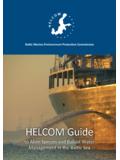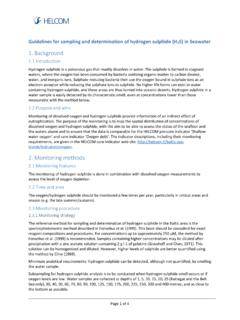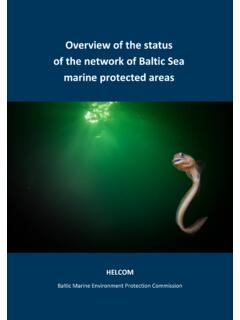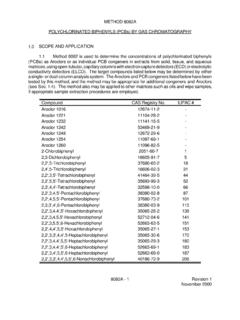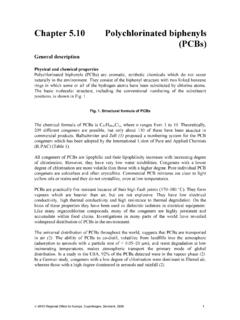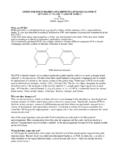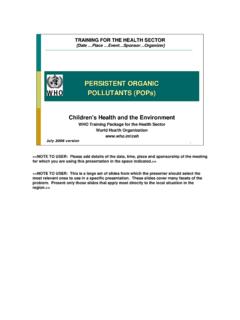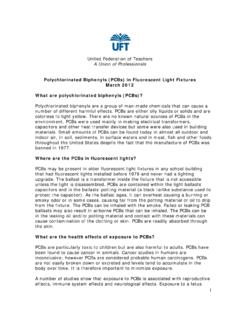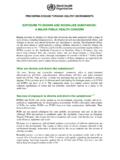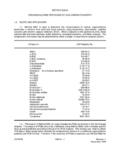Transcription of Polychlorinated biphenyls (PCB) and dioxins and furans
1 HELCOM Core Indicator of Hazardous Substances Polychlorinated biphenyls (PCB) and dioxins and furans Polychlorinated biphenyls (PCB) and dioxins and furans - CB-28, 52, 101, 118, 138, 153 and 180: WHO-TEQ of dioxins , furans dl-PCBs Authors Elin Boalt, Elisabeth Nyberg, Anders Bignert, Jenny Hedman, Sara Danielson and the CORESET expert group for hazardous substances indicators. Reference to this core indicator report: [Author's name(s)], [Year]. [Title]. HELCOM Core Indicator Report. Online. [Date Viewed], [Web link]. HELCOM 2013 Page 1. HELCOM Core Indicator of Hazardous Substances Polychlorinated biphenyls (PCB) and dioxins and furans Contents Key messages.
2 3. Current status in the Baltic Sea .. 4. General Information .. 4. General properties .. 4. Main impacts on the environment and human health .. 5. Policy relevance .. 5. Status of a compound on international priority lists and other policy relevance .. 5. Status of restrictions, bans or use .. 6. Assessment of PCBs, dioxins and furans in the Baltic Sea .. 6. Concentrations of PCBs and dioxins .. 6. Temporal trends .. 9. 10. Data source .. 14. Figures are produced on the basis of the HELCOM data from the ICES and EIONET databases and complemented by Swedish national monitoring data and Finnish screening studies.
3 14. Description of data .. 14. Geographic coverage .. 14. Current monitoring of the indicator .. 14. Geographical relevance of the indicator .. 15. Methodology and frequency of data collection .. 15. Methodology of data analyses .. 15. Preferred matrix .. 15. Determination of GES boundary .. 16. Strengths and weaknesses of 19. References .. 19. Annex 1.. 21. HELCOM 2013 Page 2. HELCOM Core Indicator of Hazardous Substances Polychlorinated biphenyls (PCB) and dioxins and furans Key messages The status of PCBs, based on two common congeners, is moderate or bad.
4 Only a few sites in the Danish Straits and Limfjorden are in Good Environmental Status (GES). dioxins have shown declining trends in most of the time series, but the decline has leveled off during the past 20. years. The concentrations are still above the threshold levels, particularly in the northern parts of the Baltic Sea. Time series show decline of PCB congeners in fish and blue mussels. Figure 1. Status of Polychlorinated biphenyls (PCBs) in 2005 2010. The congeners CB-118 (left) and CB-153 (right). representing all the PCBs are compared against the Background Assessment Criteria (BAC) ( Below BAC'.)
5 Denoted by green color and Above BAC' by yellow color) and the Environmental Assessment Criteria (EAC) (red color). See Methods for the threshold concentrations. HELCOM 2013 Page 3. HELCOM Core Indicator of Hazardous Substances Polychlorinated biphenyls (PCB) and dioxins and furans Legend Herring Figure 2 Status of dioxins (left) and dioxins + dioxin -like Polychlorinated biphenyls (PCBs) in 2005 2010. GES. -1. boundaries are and ng kg WHO2005-TEQ. See Methods for the threshold concentrations. [several results are missing]. Current status in the Baltic Sea The status maps of the two common PCB congeners CB-118 and CB-153 indicate that the PCB concentrations are still high in the Baltic fish and blue mussels and do not reach GES except in a few sites in Denmark and one site in Gulf of Gdansk (Figure 1).
6 The boundary for the Good Environmental Status was selected to represent the OSPAR. Background Assessment criteria (see discussion in Metadata) and the transition from the moderate' to bad' status is indicated by the OSPAR Environmental Assessment Criteria. The dioxin concentrations in herring are mostly under the GES boundaries, representing good environmental status (Figure 2). General Information General properties Polychlorinated biphenyls (PCBs) and PCDD/Fs ( dioxins ) are persistent organic pollutants (POPs) that can cause severe, long-term impacts on wildlife, ecosystems and human health.
7 The substance groups are characterized by low water solubility and low vapor pressure. Due to their persistent and hydrophobic properties, the substances accumulate in sediments and organisms in the aquatic environment. In the environment, dioxins can undergo photolysis, however, they are generally very resistant to chemical and biological degradation. Polychlorinated biphenyls (PCBs) consist of two linked benzene rings with chlorine atoms substituted for one or more hydrogen atoms. Theoretically, 209 congeners are possible, but only around 130 are found in commercial mixtures.
8 Some PCBs are called dioxin -like (dl-PCBs) because they have a co-planar structure very similar to that of dioxins and have dioxin -like effects ( four non-ortho substituted PCBs: CB-77, CB-81, CB-126, CB-169, IUPAC and eight mono- ortho substituted: CB-105, CB-118, CB-156, CB-157, CB-167, CB-114, CB-123, CB-189, IUPAC) (Burreau et al. 2006). The HELCOM 2013 Page 4. HELCOM Core Indicator of Hazardous Substances Polychlorinated biphenyls (PCB) and dioxins and furans name ' dioxin ' refers to Polychlorinated dibenzo-p- dioxin (PCDD) and dibenzofuran (PCDF) compounds, two benzene rings with one ( furans ) or two ( dioxins ) oxygen bridges and substituted with 1 8 chlorine atoms.
9 Of the 210. possible congeners, the 17 compounds (10 furans , 7 dioxins ) substituted in positions 2,3,7,8 are considered to be of highest toxicological importance. PCBs are synthetic chemicals and do not occur naturally in the environment. Due to their properties, PCBs have been used in a wide variety of applications and manufacturing processes, especially as plasticizers, insulators and flame- retardants. They are widely distributed in the environment through, for example, inappropriate handling of waste material or leakage from transformers, condensers and hydraulic systems.
10 According to some estimates, the total global production of PCBs from 1930 to the ban in most countries by the 1980s had already been in the order of million tons. PCDD/Fs were never produced intentionally, but they are minor impurities in several chlorinated chemicals ( , PCBs, chlorophenols, hexachlorophene, etc.), and are formed in several industrial processes and from most combustion processes, such as municipal waste incineration and small-scale burning under poorly controlled conditions. Formerly, pulp bleaching using chlorine gas was an important source of PCDD/Fs.
